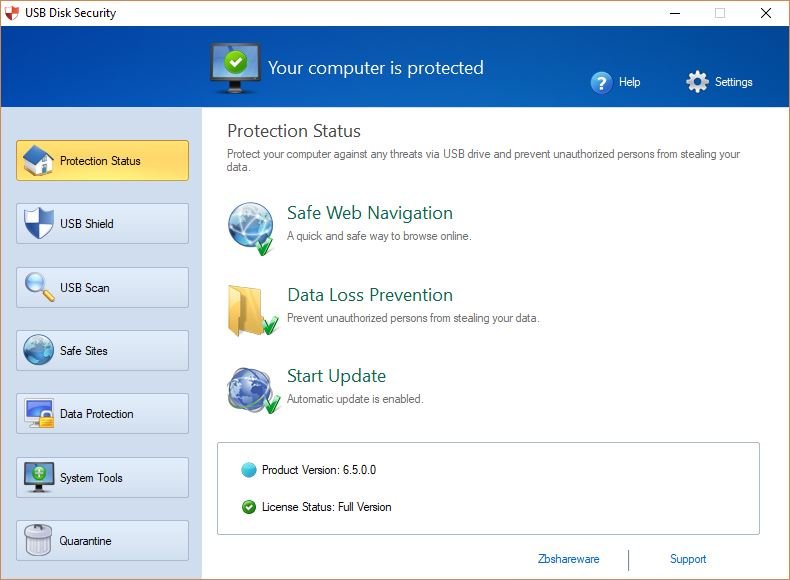

- #USB DISK SECURITY WINDOWS 8.1 FULL#
- #USB DISK SECURITY WINDOWS 8.1 PORTABLE#
- #USB DISK SECURITY WINDOWS 8.1 SOFTWARE#
- #USB DISK SECURITY WINDOWS 8.1 PC#
This has made USB flash drives a leading form of information system infection.
#USB DISK SECURITY WINDOWS 8.1 SOFTWARE#
Today, USB flash drives perform the same data and software storage and transfer role as the floppy disk, often used to transfer files between computers which may be on different networks, in different offices, or owned by different people. In the early days of computer viruses, malware, and spyware, the primary means of transmission and infection was the floppy disk. USB flash drives with US Army classified military information were up for sale at a bazaar outside Bagram, Afghanistan.a USB drive was stolen with names, grades, and social security numbers of 6,500 former students.HM Revenue & Customs lost personal details of 6,500 private pension holders.Ī SanDisk survey characterized the data corporate end users most frequently copy:Įxamples of security breaches resulting from USB drives include: The average cost of a data breach from any source (not necessarily a flash drive) ranges from less than $100,000 to about $2.5 million. While many enterprises have strict management policies toward USB drives and some companies ban them outright to minimize risk, others seem unaware of the risks these devices pose to system security. Usage: tracking corporate data stored on personal flash drives is a significant challenge the drives are small, common and constantly moving.Storage: USB flash drives are hard to track physically, being stored in bags, backpacks, laptop cases, jackets, trouser pockets or left at unattended workstations.The following factors should be taken into consideration for securing important assets:

The large storage capacity of USB flash drives relative to their small size and low cost means that using them for data storage without adequate operational and logical controls may pose a serious threat to information availability, confidentiality and integrity. USB flash drives pose two major challenges to information system security: data leakage owing to their small size and ubiquity and system compromise through infections from computer viruses, malware and spyware. The consequences of losing drives loaded with such information can be significant, including the loss of customer data, financial information, business plans and other confidential information, with the associated risk of reputation damage.
#USB DISK SECURITY WINDOWS 8.1 PORTABLE#
As both consumers and businesses have increased demand for these drives, manufacturers are producing faster devices with greater data storage capacities.Īn increasing number of portable devices are used in business, such as laptops, notebooks, personal digital assistants (PDA), smartphones, USB flash drives and other mobile devices.Ĭompanies in particular are at risk when sensitive data are stored on unsecured USB flash drives by employees who use the devices to transport data outside the office. USB flash drive products have been on the market since 2000, and their use is increasing exponentially. Secure USB flash drives protect the data stored on them from access by unauthorized users. ( September 2009) ( Learn how and when to remove this template message) Please help to improve this article by introducing more precise citations. To format the partition, type format fs=ntfs quick, and then click ENTER.This article includes a list of general references, but it lacks sufficient corresponding inline citations. To select the partition that you just created, type select partition 1, and then click ENTER. To create a new primary partition on the USB flash drive, type create partition primary, and then click ENTER. This command deletes all data from the USB flash drive. Note the drive number or drive letter of the USB flash drive.Īt the command prompt, type select disk, where X is the drive number or drive letter of the USB flash drive, and then click ENTER. The list disk command displays all the disks on the computer. In the new command line window that opens, to determine the USB flash drive number or drive letter, at the command prompt, type list disk, and then click ENTER. Open a Command Prompt window as an administrator.

Insert a USB flash drive into a running computer. Restore or repair your server running Windows Server Essentials
#USB DISK SECURITY WINDOWS 8.1 FULL#
Restore a full system from an existing client computer backup
#USB DISK SECURITY WINDOWS 8.1 PC#
To create a bootable USB flash drive for use in recovering or reinstalling Windows on a PC instead of a server, see Create a recovery drive.įor additional scenarios in which you may want to create or use a bootable USB flash drive, see the following topics:


 0 kommentar(er)
0 kommentar(er)
